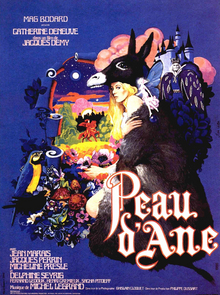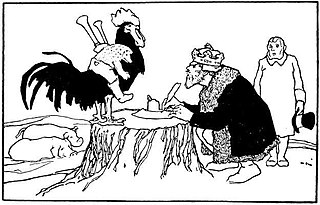Synopsis

There once was a lord who had many fine estates and who wished to leave them to a son. When a daughter is born to him instead, he is very unhappy and will not even look at her.
When she is fifteen, her father is willing to marry her off to the first man who offers. When she hates the first man who offers, she goes to a hen-wife, who advises her to demand a coat of silver cloth before the wedding. When her father and suitor provide that, the hen-wife advises a coat of beaten gold, and then a coat made from feathers of all the birds, and then a little coat of catskin.
The daughter puts on the Catskin coat and runs away, disguising herself as a peasant girl. She finds a place as a scullion at a castle and works in the kitchens.
When a ball is held at the castle, the daughter, called "Catskin" by the others in the kitchen, asks to be allowed to attend. The cook is amused at her request and throws a basin of water in her face, but Catskin bathes and dresses herself in the coat of silver cloth, and goes to the ball. The young lord falls in love with her, but when he asks where she came from, she only replies from the Sign of the Basin of Water.
The young lord holds another ball, in hopes she will attend. The cook breaks a ladle across Catskin's back when she says she would like to go, but Catskin goes in her coat of beaten gold, and when the lord again asks where she is from, Catskin replies that she came from the Sign of the Broken Ladle.
The young lord holds a third ball. The cook breaks a skimmer across Catskin's back when she asks permission to attend, but Catskin goes in her coat of feathers, and says she came from the Sign of the Broken Skimmer. The young lord follows her, and sees her change into her catskin coat.
The young lord goes to his mother and announces that he will marry Catskin. His mother is opposed, and the young lord, so distraught, takes ill. His mother then agrees to the marriage. When Catskin appears before her in the coat of gold, the mother says she is glad her daughter-in-law is so beautiful.
Soon, Catskin gives birth to a son. One day, a beggar woman appears with her child, and Catskin sends her son to give them money. The cook says that beggars' brats will get along, and Catskin goes to her husband and begs him to discover what happened to her parents.
Her husband finds her father, who never had another child and lost his wife, and asks him whether he had a daughter. Catskin's father tells the lord that he had a daughter, and says that he would give all that he owns to see her again. Catskin's husband takes her father to see his daughter and then brings him to stay with them at the castle.
In some versions of the tale, Catskin asks to simply see the ball or serve the food, and not actually attend it.







